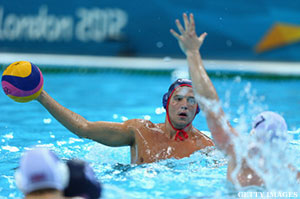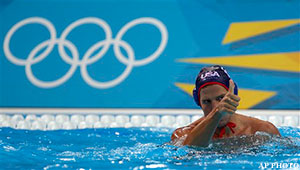How long can you tread water? The fact that world-class water polo players are basically prepared to keep themselves afloat for indefinite amounts of time highlights their dedication to fitness, as well as pointing out the difficulty of their sport right off the bat.

But aside from water polo being a sport in which the players never get to rest while they're in the game, there are other aspects of the sport that make it so challenging. You have to be able to stay far above the water's surface to make plays on offense and defense, and you’ll need at least one arm out of the water to be effective on both sides of the ball. Plus, all players, goalies in particular, need to be able to propel themselves out of the water without their feet touching the ground -- touching the bottom of the pool isn't allowed at any time. Plus, the game is extremely physical between the players, making it an intensely demanding sport for the duration of the game, which will last for four eight-minute quarters in the Olympics.
Water polo is one of the modern Olympics' oldest institutions, dating all the way back to 1900. Although often overlooked in the U.S., the game is actually quite popular in certain parts of Europe, such as Italy and Greece, where there are professional leagues, and Hungary, where water polo is the national sport. On that note, Hungary is the biggest world power in the game, having collected gold medals in the last three Summer Olympics.
However, according to Shea Buckner, an attacker for the U.S. water polo team, the U.S. recently defeated Hungary in a match (along with another win over Croatia), and he also says most of the 12 men’s water polo teams headed to London this summer have a decent shot at taking the tournament, so Hungary will have plenty of challengers.

Buckner says the fitness required to play water polo at an Olympic level is truly in a league of its own, even in comparison to other sports in the elite levels. "We swim well over 2 miles per match, we cannot touch the bottom of the pool, all while wrestling and fighting with another 6-5, 250-lb. opponent," he says. "If that wasn't hard enough, we then have to make accurate decisions, precision passes, and ultimately score while under tremendous physical strain."
The training it takes to get a player through a game in one piece is, as you would expect, incredibly intense. In fact, it would probably qualify as grueling, even for guys that consider themselves fit. Here's a basic breakdown of a typical day with the U.S. team from Buckner:
7:45 a.m.-9:45 a.m. - Lifting weights
9:45 a.m.-12 p.m. - Swim 6,000 to 8,000 yards. This is about 3.5-4.5 miles.
7:00 p.m.-10:00 p.m. - Swim another 3,000 to 5,000 yards; approximately 2-3 miles.
After this, it’s on to working on game tactics and leg conditioning.
Over seven hours of pushing the body to its absolute limit in just one day of training -- it definitely sounds like an Olympian effort. Training hones in on building plenty of leg strength, since the best players are the strongest ones, with the ability to elevate out of the water from the force of their legs and core. Players constantly churn their legs independent of one another in a circular motion to stay above the water, a technique known as the "egg-beater."

The skill allows players to remain stable above the water while also keeping arms free to play the game. Of course, the technique takes a tremendous amount of leg strength, and general body strength, to sustain it for such a long period of time. Even with all the training, Buckner says players usually substitute every two to three minutes to stay fresh.
Interestingly, the physique of a water polo player depends on the position in the game.
"Attackers are normally leaner and faster, while centers are much more bulky,” Buckner says. “Defenders and centers are normally the tallest players and also strongest in the pool, but what attackers give up weight and strength, they make up for in speed."
If you're looking to shake up your workouts a bit, consider emulating some of the hard work put in by world-class water polo players. For starters, Buckner suggests working on power cleans to develop all-around strength. In the pool, he suggests treading water by mastering the egg-beater technique, gradually raising your hands and then elbows out of the water over time as you develop the skill. If you can do this for 30 minutes at once, as Buckner suggests, you might have a future as a water polo player.
More From Men's Fitness:
-- America's Best Barbecue Restaurants
-- 5 Simple Tips To Better Sex
-- Best Beer Gardens In America





